October 31 - November 7, 2002
"Tower Site" Does Dallas, part I
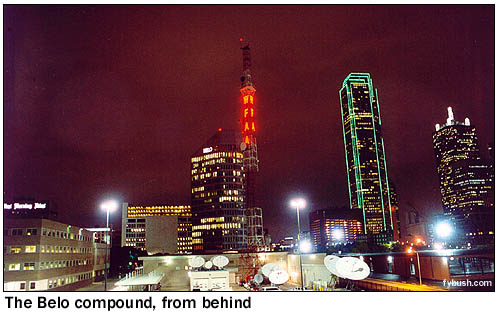 It's
the nation's fifth-largest radio market. It's
the nation's fifth-largest radio market.
It's TV market number seven.
It's the place where Gordon McLendon achieved top-40 immortality,
the spot where those PAMS and JAM and TM Century jingle singers
did all those jock shouts.
It's where TV news came of age 39 years ago this month.
It's the town where Radio Disney and a dozen other satellite
formats originate, to be sent to a station near you - and you
- and you, too.
It's got the biggest AM arrays, some of the tallest FM towers,
and the most FM radio signals per capita of any major market.
Yes, my friends, we're talking about the Big D, and we do
mean Dallas - and Fort Worth, too - and for the next few
weeks, it'll be our focus here on Tower Site of the Week as we
recap a whirlwind couple of days in the Big D in mid-October.
Our visit to the Metroplex began on a Thursday afternoon,
as your editor touched down at DFW Airport, followed shortly
by co-conspirator Garrett Wollman's arrival from Boston. The
usual rental-car and hotel business behind us, we set off for
what has to be one of the neatest radio studio sites in the country.
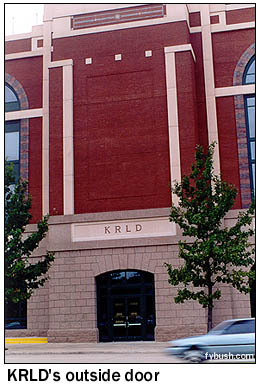 For
while you've no doubt heard of KRLD (1080 Dallas) - and even
may have heard it in the Northeast during that coordinated DX
test with WTIC a couple of years ago - you may not realize that
the Infinity news station's broadcasts come from a studio located,
quite literally, in the Ballpark at Arlington, home to
the Texas Rangers. For
while you've no doubt heard of KRLD (1080 Dallas) - and even
may have heard it in the Northeast during that coordinated DX
test with WTIC a couple of years ago - you may not realize that
the Infinity news station's broadcasts come from a studio located,
quite literally, in the Ballpark at Arlington, home to
the Texas Rangers.
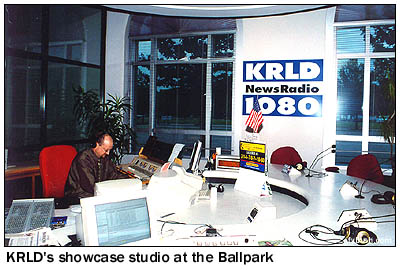
KRLD moved in a few years ago, as part of its long-term deal
to be the Rangers' flagship radio voice, and what a space it
is! The main entrance (behind those nondescript doors on the
outside wall of the Ballpark) features a big tiled floor announcing
"KRLD/TSN" - not "The Sports Network" of
Canadian fame but the "Texas State Network" news web
- and once inside, you're greeted with two stories of windows
looking out on left field!
KRLD's operations manager, Tyler Cox (some New Englanders
might remember him from his stint as PD of WBZ in the late eighties,
and Washingtonians might remember him from WRC; he came to Dallas
a decade ago to run WBAP before being lured across I-30 to KRLD),
gave us the grand tour of the newsroom and studios, which still
show the configuration designed for KRLD's talk format; it's
just within the last year that the 50kW station has gone all-news,
all-day, and there's still talk at night and on weekends (including
a nifty Saturday-night show called "The Lost Tapes"
that resurrects old music and KRLD airchecks!)
From KRLD, we headed into downtown Dallas to meet up with
our tour guide for the rest of the trip, Wally Wawro of WFAA-TV
(Channel 8). Wally's a fellow member of the National
Radio Club; in fact, he's one of the co-hosts of next year's
NRC convention back here in Dallas.
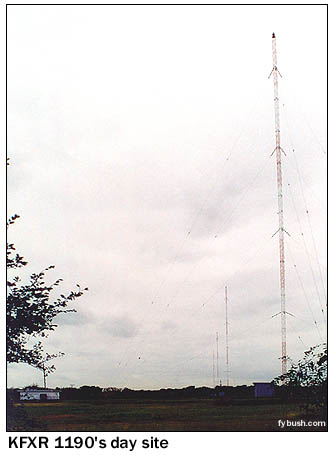 And what a tour guide!
We began with an exhaustive look at the WFAA studios, seen above
from the parking garage at the south end of the big Belo complex
that stretches along Young Street at the south end of downtown. And what a tour guide!
We began with an exhaustive look at the WFAA studios, seen above
from the parking garage at the south end of the big Belo complex
that stretches along Young Street at the south end of downtown.
Just to the left of the studio-transmitter link tower, you
can see Belo corporate headquarters; at the left side of the
picture is the flagship Dallas Morning News, and that's
the Channel 8 studio building at center. Off to the left of the
frame is another building that houses TXCN, "Texas Cable
News," another Belo venture. And while it's not shown here,
the WFAA lobby features an extensive historical display about
the first TV station in Dallas/Fort Worth (yes, WFAA!)
Dinner at the local Dickey's barbeque chain follows (the latest
link in our informal barbecue tour of America, which has also
landed us in Kansas City and Birmingham in the last year or so),
then a quick stop to see the studios of oldies KLUV (98.7) and
a run out to Rockwall, 30 miles or so to the east of downtown
Dallas (if you don't know why, we'll explain in Part 3!) and
then it's back to the hotel for a good night's sleep before another
full day of towering.
Friday dawns cloudy as Wally and John Callarman, another longtime
NRC member and co-host of the 2003 convention, arrive at our
hotel to begin the tower tour, and we're soon off to a few less-than-spectacular
sites not far from our hotel in Arlington, halfway between Dallas
and Fort Worth.
The two towers of KKDA (730 Grand Prairie) didn't even make
the cut for display here; about a mile away are the four towers
in a row that serve KFXR (1190 Dallas) by day. Exciting? Not
very - but wait until you see the night site of 1190 in
an upcoming segment. (And it is 50,000 watts, anyway...)
Continuing in the area, we pull up along MacArthur Road to
see a six-tower site set amidst the floodplain of the Trinity
River North Branch, with cattle grazing near the towers and a
transmitter building set well above flood level on big concrete
pillars.
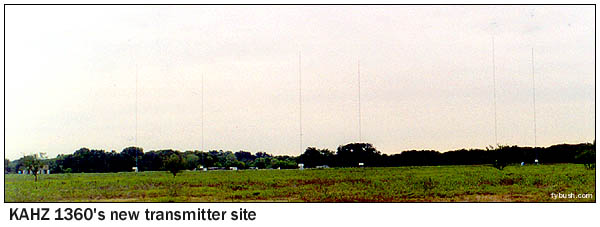 This is a very new
site - just on the air within the last few months - and it's
home to a station that used to be local to Fort Worth, KAHZ (1360).
From this new site halfway between Fort Worth and Dallas, and
with a new city of license of Hurst, Texas, KAHZ (the calls come
from a long-ago stint as a Radio Aahs affiliate) hopes to serve
both cities with its 50kW daytime signal. With 890 watts after
dark, it should still serve Grand Prairie, at least... This is a very new
site - just on the air within the last few months - and it's
home to a station that used to be local to Fort Worth, KAHZ (1360).
From this new site halfway between Fort Worth and Dallas, and
with a new city of license of Hurst, Texas, KAHZ (the calls come
from a long-ago stint as a Radio Aahs affiliate) hopes to serve
both cities with its 50kW daytime signal. With 890 watts after
dark, it should still serve Grand Prairie, at least...
And now we're off to one of the major highlights not only
of this trip but of our career as tower-hunters: heading south
to Cedar Hill, the small community some 20 miles southwest of
Dallas that's home to one of the biggest concentrations of tall
towers anywhere in America.
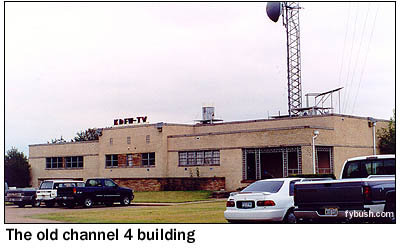 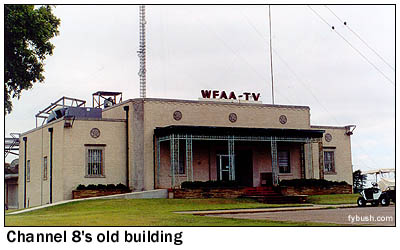
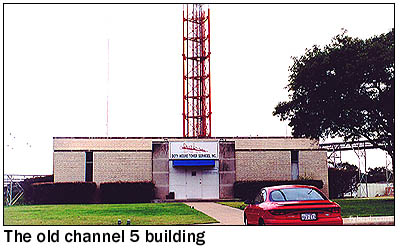 The
history of Cedar Hill is closely bound up with the history of
WFAA, and it goes something like this: WFAA signed on in 1949
as KBTV, operating from a short tower and a little studio on
Harry Hines Boulevard at what was then the northern extreme of
Dallas. The Morning News, which already owned WFAA radio,
bought KBTV soon after its debut and changed the calls to WFAA-TV. The
history of Cedar Hill is closely bound up with the history of
WFAA, and it goes something like this: WFAA signed on in 1949
as KBTV, operating from a short tower and a little studio on
Harry Hines Boulevard at what was then the northern extreme of
Dallas. The Morning News, which already owned WFAA radio,
bought KBTV soon after its debut and changed the calls to WFAA-TV.
It was quickly followed by two more stations in the area:
KRLD-TV, owned by the Dallas Times-Herald and KRLD
radio, on channel 4; and Amon Carter's WBAP-TV, channel 5, 35
miles away in Fort Worth, paired with WBAP radio and the Fort
Worth Star-Telegram.
WFAA and KRLD realized within a few years that Dallas and
Fort Worth would be a single TV market, and the best spot to
reach the whole area would be Cedar Hill. In 1954, they formed
the Hill Tower Company, bought a huge parcel of land in the area
west of US 67, and built a candelabra tower, flanked on the left
by the channel 4 transmitter building and on the right by the
channel 8 transmitter building. The tower, ordered as part of
a turnkey deal from RCA (back when there was an RCA Broadcast!),
was an Ideco-Dresser, 1439 feet to the base of the candelabra
and almost 1510 feet to the top of the antennas. (This was, after
all, Texas.)
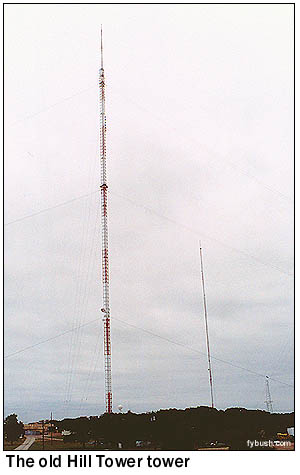 WBAP-TV,
meanwhile, kept transmitting from its site on Broadcast Hill,
just east of downtown Fort Worth - which meant that its signal
in Dallas was nowhere near as good as the new channel 4 and 8
signals. Amon Carter was well known for his dislike (and that's
the kind term) for Dallas, and legend has it that he didn't much
care whether people there could see channel 5. Unfortunately,
the brass at NBC in New York didn't share that opinion, and legend
has it that they told Carter they'd pull the affiliation if he
didn't join the other stations at Cedar Hill. WBAP-TV,
meanwhile, kept transmitting from its site on Broadcast Hill,
just east of downtown Fort Worth - which meant that its signal
in Dallas was nowhere near as good as the new channel 4 and 8
signals. Amon Carter was well known for his dislike (and that's
the kind term) for Dallas, and legend has it that he didn't much
care whether people there could see channel 5. Unfortunately,
the brass at NBC in New York didn't share that opinion, and legend
has it that they told Carter they'd pull the affiliation if he
didn't join the other stations at Cedar Hill.
So WBAP-TV and WBAP-FM (96.3) built their own building, right
between the existing two and directly in front of the tower,
and all three major networks (KRLD-TV was the CBS affiliate,
WFAA was and has always been ABC) had signal parity in the market.
WBAP and KRLD both ended up being sold away from their radio
and newspaper partners, so channel 5 eventually became KXAS-TV
and channel 4 KDFW-TV, but the happy Hill Tower consortium stayed
in place - and what a sight it must have been, pulling in to
the driveway off Belt Line Road, between the big brick entrance
walls and up to the panorama of the three transmitter buildings,
call signs proudly emblazoned above them, and the huge tower
behind them!
Inside the WFAA-TV building, the RCA TT-11 transmitter installed
in 1954 eventually gave way to a newer Harris; somewhere in here,
WFAA-FM (97.9) also installed its transmitter.
Around the site, Hill Tower began leasing land to other stations
to build their own towers, as the Dallas-Fort Worth dial lit
up with new UHF and FM facilities. And at its own site on Belt
Line Road, everything just kept chugging along - until Wednesday,
January 4, 1987, when a Navy F-4 jet on approach to the nearby
Dallas Naval Air Station (which has since closed) clipped several
of the guy wires to the candelabra. The pilot and co-pilot ejected
before the plane crashed and survived; the tower suffered severe
damage, including the loss of several transmission lines, knocking
the stations there off the air.
The tower was insured, of course, and the Hill Tower consortium
was ready to rebuild. But the insurance companies said the old
tower was unsafe above the spot where the plane hit, so while
it could remain in use as an auxiliary facility (trimmed back
to the thousand-foot level), the original plan to simply rebuild
the candelabra and carry on was unworkable.
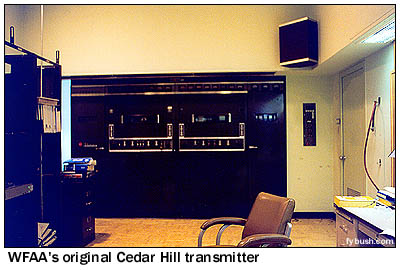 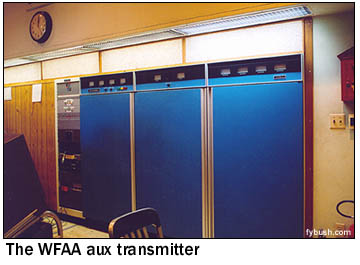
And so it came to pass that the KDFW and WFAA transmitter
buildings became auxiliary transmitter buildings - and the KXAS
building became vacant, as channel 5, never a member of the Hill
Tower consortium, built its own tower nearby. Channels 4 and
8 stayed together, though. In our next installment, we'll continue
our look at Cedar Hill with a tour of that state-of-the-art
facility just behind the old tower - and much, much more!
Special thanks to WFAA transmitter
engineer Don Guemmer, Wally Wawro, John Callarman, Chris Huff
of KSCS, Wayne Kube at Belo corporate, and KRLD's Tyler Cox!
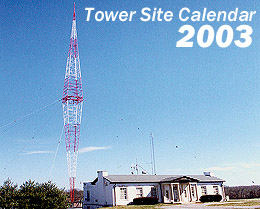 Like our recent WTIC picture? It's
one of the more than a dozen Tower Site images featured in the
2003 Tower Site Calendar, coming this fall from Tower Site of
the Week and fybush.com. Like our recent WTIC picture? It's
one of the more than a dozen Tower Site images featured in the
2003 Tower Site Calendar, coming this fall from Tower Site of
the Week and fybush.com.
If you liked last year's edition, you'll love this one: higher-quality
images (in addition to Avon Mountain, this year's edition includes
Providence's WHJJ; Mount Mansfield, Vermont; Buffalo's WBEN;
KOMA in Oklahoma City; the legendary WSM, Nashville; Brookmans
Park, England; WPAT, Paterson; Four Times Square, New York; WIBC
in Indianapolis and more), more dates in radio history, a convenient
hole for hanging - and we'll even make sure all the dates fall
on the right days!
This year's calendar will go to press in late October, and
if you order now, you'll have yours in hand by mid-November,
in plenty of time for the holidays. And this year, you can order
with your Visa, MasterCard, Discover or American Express by using
the handy link below!
Better yet, here's an incentive to make your 2003 NERW/Site
of the Week subscription pledge a little early: support NERW/fybush.com
at the $60 level or higher, and you'll get this lovely calendar
for free! How can you go wrong? (Click here
to visit our Support page, where you can make your NERW contribution
with a major credit card...)
You can also order by mail; just send a check for $16
per calendar (NYS residents add 8% sales tax), shipping included,
to Scott Fybush, 92 Bonnie Brae Ave., Rochester
NY 14618.
Thanks for your support!
|